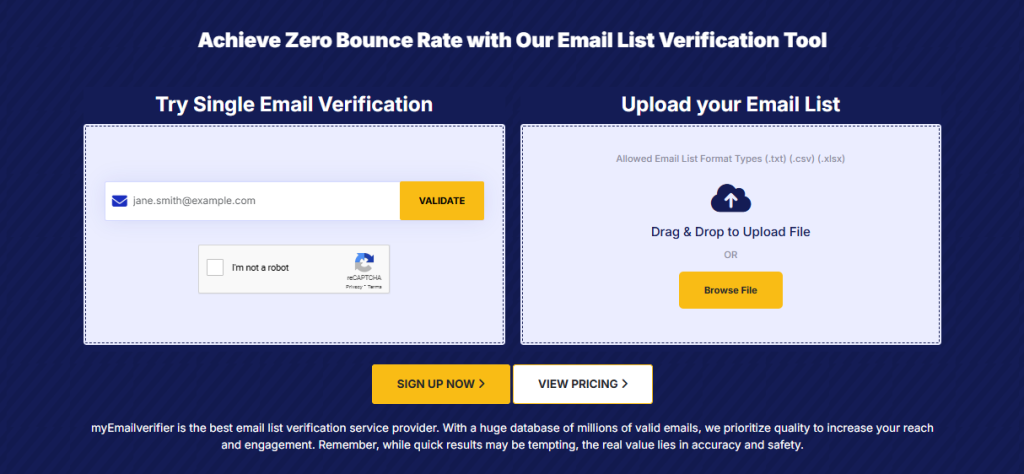When it comes to email marketing, sending messages to invalid or incorrect email addresses can significantly reduce your success. Bounced emails, low engagement, and potential damage to your sender’s reputation are all risks you face if your email list is not properly verified. Also, if you are sure that the email address is correct you will try it. If you’ve ever hit send only to realize that some of your contacts were unreachable, you know how frustrating that can be.
Email marketing is a powerful tool, but its effectiveness relies heavily on the quality of your contact list. Ensuring that your emails reach the right inboxes is critical for boosting deliverability and maintaining positive relationships with your customers. The key to achieving this? Email verification tool.
Email verification acts as a safeguard, confirming that the addresses on your list are valid and ready to receive your messages. In this guide, we’ll walk you through the process of mastering email verification and show you how to ensure accuracy before you hit send. Let’s get started!
Why Email Verification is Important?
Email verification is the process of confirming that the email addresses in your list are valid and able to receive messages. There are a few key reasons why this is essential for your email campaigns:
Improve Deliverability: Invalid or inactive email addresses can result in hard bounces, which can impact your overall deliverability. By verifying emails before sending, you can avoid sending messages to addresses that no longer exist or are inactive.
Read: How To Check Email Deliverability: The Easiest Method!
Protect Your Sender Reputation: If you repeatedly send emails to invalid addresses, your email service provider may flag your account as a source of spam. Maintaining a clean, verified list helps protect your sender’s reputation and ensures that your emails are more likely to land in the inbox.
Reduce Bounce Rates: High bounce rates are not only frustrating, but they also signal to email service providers that your campaigns aren’t targeted effectively. A lower bounce rate helps maintain high sender scores, which is critical for successful campaigns.
Read: 12 Top Reasons Emails Bounce (and How to Fix Them)
Enhance Engagement: When your emails are sent to active, interested recipients, your open and click-through rates improve. Verifying email addresses helps you ensure that your messages are reaching the most engaged audience possible.
How to Verify Email Addresses Before Sending?
Email verification is a multi-step process that involves checking for various aspects of an email address to ensure its validity. Here are the best practices for verifying emails before sending them out:
1. Use an Email Verification Tool
The most efficient way to verify email addresses is by using an email verification tool. These tools check for common issues such as invalid domains, syntax errors, and temporary or disposable email addresses.
A reliable email checker tool will perform several key tasks:
Syntax Check: It ensures that the email address follows the correct format (e.g., [email protected]).
Domain Validation: It verifies whether the domain name (e.g., gmail.com) is valid and capable of receiving emails.
Blacklist Check: It checks if the domain or email address is blacklisted due to suspicious activity.
Disposable Email Detection: It identifies temporary, one-time-use email addresses that are often used for single sign-ups.
By using a verification tool, you can quickly identify and remove problematic email addresses before they cause any issues.
2. Use Double Opt-In
Double opt-in is an excellent method for ensuring that the email addresses you collect are both valid and accurate. With double opt-in, new subscribers are asked to confirm their email addresses by clicking a verification link sent to their inbox. This additional step ensures that the email address is active, and it also confirms that the person signing up genuinely wants to receive your communications.
Double opt-in serves a dual purpose: it not only improves the quality of your email list but also reduces the chances of your emails being marked as spam. It’s a proactive way to ensure that your messages go to engaged and interested recipients.
3. Clean Your Email List Regularly
Email addresses can become inactive or outdated over time, so it’s important to keep your list up to date. Regularly cleaning your email list helps remove addresses that have been inactive for a long time or that have become invalid. If you notice a consistent lack of engagement from certain subscribers, it’s a good idea to remove them from your list. This helps you focus on those who are truly interested in your content and prevents unnecessary email bounces.
You can clean your list manually or use a tool to do it automatically. Many email checker tools also offer list-cleaning features that remove invalid or risky addresses in bulk.
Read: Top 10 Bulk Email Verification Tools: A Comprehensive Comparison
4. Validate Email Addresses in Real-Time
Real-time email validation helps ensure that email addresses entered on your website, sign-up forms, or during checkouts are valid right from the start. Implementing real-time email validation means that if a user enters an incorrect or invalid address, the system will immediately alert them to correct it before submission.
This proactive approach prevents errors from entering your email list in the first place, saving you time and effort. Real-time validation also reduces the chances of user frustration, as they can correct mistakes immediately rather than receiving undeliverable emails later.
5. Monitor Engagement Levels
Once you’ve sent your emails, monitoring how recipients engage with your content is crucial. Low engagement rates could indicate issues with the quality of your list or the relevance of your messaging. Regularly track open rates, click-through rates, and other engagement metrics to identify patterns. If certain recipients consistently ignore your emails, it may be time to remove them from your list to maintain a healthy, responsive audience.
6. Use a Spam Trap Checker
Spam traps are email addresses ISPs use to detect and catch senders who use poor list management practices. Sending emails to spam traps can negatively impact your sender’s reputation and lead to being blacklisted. A spam trap checker ensures that the email addresses in your list are clean and free from known spam traps, helping to protect your reputation and improve deliverability.
Common Mistakes to Avoid While Verifying Email Addresses
While email verification is critical for ensuring accuracy, there are a few common mistakes that marketers should avoid:
Relying on Outdated Data: Even if you’ve verified email addresses in the past, it’s important to regularly update and clean your list. Email addresses can change over time, and old, inactive addresses should be removed.
Neglecting Real-Time Validation: Implementing real-time email validation can prevent many issues from arising, but some businesses skip this step. Not validating emails in real-time can result in incorrect or invalid addresses entering your list.
Ignoring Engagement Metrics: Don’t just rely on verification tools—make sure to monitor engagement and clean your list based on user activity. Inactive or disengaged subscribers may need to be removed from your list to maintain its health.
Verify Your Emails Instantly to Ensure Accuracy
Test Your Email List for Errors Now
Final Words
Mastering email verification is a critical step in ensuring the success of your email marketing campaigns. By using verification tools, not only does this help protect your sender reputation, but it also ensures your messages reach the right audience, boosting engagement and ROI.
One tool that stands out in simplifying the email verification process is myEmailVerifier. This service offers a robust set of features, including bulk email verification, real-time validation, and the ability to detect spam traps, invalid emails, and disposable addresses. Taking the time to verify email addresses before hitting send can make all the difference in achieving successful email campaigns and maintaining a healthy email list. It’s an investment that pays off by reducing errors, saving time, and improving the performance of your email marketing efforts.
James P. is Digital Marketing Executive at MyEmailVerifier. He is an expert in Content Writing, Inbound marketing, and lead generation. James’s passion for learning about people led her to a career in marketing and social media, with an emphasis on his content creation.

